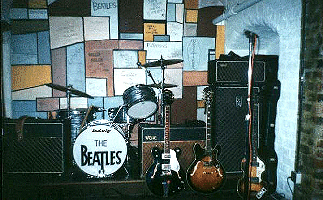


 |
 |
 |
 |
Meetings
were followed by more meetings and eventually permission was finally given
for the go ahead. The original plan was to rebuild the old Cavern as it
was thought that the underground club would still be intact below the hastily-built
car park above it. Unfortunately, on careful examination by structural engineers,
it was discovered that the club's ceilings and general fabric had collapsed
so the original Cavern could never be resurrected. The area above the club was also important as this was required for the building of the shopping centre. As portions of the land were owned by Mersey Railways, having been acquired during the original demolition of The Cavern in 1973, it was decided to scrap plans to rebuild the original Cavern and build a replica Cavern underneath the new shopping centre to be sited further down Mathew Street. For this task it was decided to re-use bricks from the now-excavated original Cavern. Over 15,000 bricks from the old Cavern were used in the reconstruction and, over the weeks of building, quite a few disappeared as many local people took away their own little piece of rock history but 5000 of the original bricks were saved and sold off by the Royal Life company in 1983 for £7.00 each. A plaque certifying their authenticity (see left) was glued to each brick with the proceeds being donated to a local charity. All of the bricks were sold out within the first year and in the late 1980s one was re-sold at auction for over £500 by Sotheby's. |
| The
new Cavern is a mock-up of the old, smaller than the original, although
it does fill 50% of the original site and retains its original postal address.
Other differences are that it is deeper set than the original and the stage
is placed to the left as you enter down the stairs (it was facing you in
the original) and the original band room is placed at the back of the stage
as opposed to the side in the original. The new Cavern also contains a bar area with a new room to one side that contains a large purpose-built stage where many local and international acts have performed, most notable being Paul McCartney's triumphant return to the site of The Cavern in 1999. The large warehouses that once stood on Mathew Street now contain a vast shopping centre that contains several floors of offices, a Beatles theme pub, a restaurant called Abbey Road and over thirty shops selling everything from designer clothes to confectionery and Beatles souvenirs. The whole of the redeveloped Mathew Street was renamed Cavern Walks and the surrounding area is now known as the Cavern Quarter. |
 |
 |
Even
though the original longer exists there are, in fact, still two 'Caverns'
in Liverpool. To see the other one, take a journey to Liverpool's seafront
and visit The Albert Dock complex which is the home of 'The Beatles Story',
a fascinating
multimedia exhibition devoted to the Fab Four. Although not a museum in the strictest sense, visitors are taken on a journey back into the past to relive the great days of The Beatles in visual and audio displays that recreate the sights and sounds of The Beatles rise to world wide fame. There, holding pride of place, is a recreation of the centre arch of the first Cavern club containing the stage and band room. |
 |
|
|